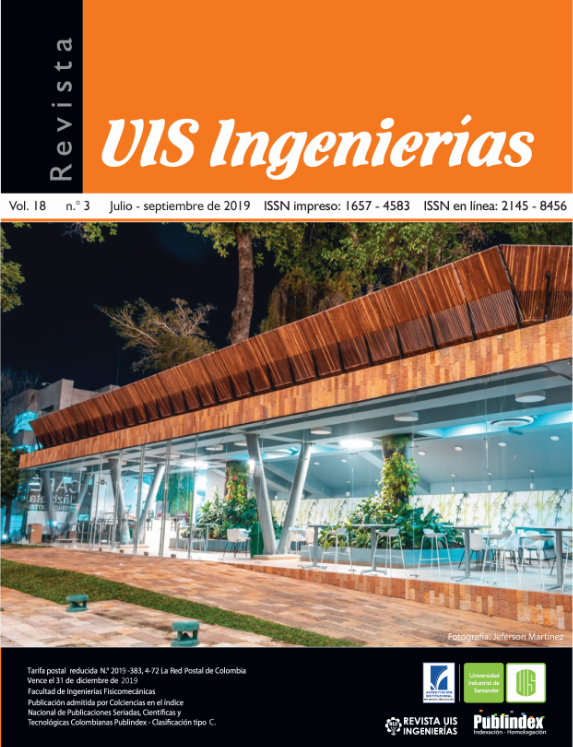Publicado 2019-04-30
Palabras clave
- álabe multi-elemento,
- turbina hidrocinética de eje horizontal,
- análisis hidrodinámico,
- longitud de cuerda,
- Javafoil
Cómo citar
Resumen
En este trabajo se presenta el dimensionamiento de los álabes de una turbina hidrocinética de 1 kW con 3 álabes con perfiles hidrodinámicos multielemento. Para ello, se implementó la teoría de Elemento de Álabe (BEM, por sus siglas en inglés). Se utilizó el perfil hidrodinámico Eppler 420 y se diseñó la turbina a partir de una velocidad de la corriente de agua de 1,5 m/s, con una relación de velocidad de punta de álabe ( ) de 6,325, un ángulo de paso de la sección del álabe ( ) de 0°, un coeficiente de potencia de 0,4382 y una eficiencia mecánica del 70%. Para el diseño del álabe, se eligió el perfil Eppler 420 multielemento, por presentar una elevada relación entre el coeficiente de elevación y arrastre. Se llevó a cabo un estudio de computación 2D en el código JavaFoil del perfil Eppler 420, con el fin de determinar la longitud de las cuerdas del elemento principal y de la solapa posterior (flap) óptima para un ángulo de deflexión del flap de 30° en condiciones de un bajo número de Reynolds.
Descargas
Referencias
[2] M. Anyi and B. Kirke, “Evaluation of small axial flow hydrokinetic turbines for remote communities,” Energy Sustain. Dev., vol. 14, no. 2, pp. 110–116, 2010. doi: 10.1016/j.esd.2010.02.003.
[3] H. J. Vermaak, K. Kusakana, and S. P. Koko, “Status of micro-hydrokinetic river technology in rural applications: A review of literature,” Renew. Sustain. Energy Rev., vol. 29, pp. 625–633, 2014. doi: 10.1016/j.rser.2013.08.066.
[4] M. J. Khan, G. Bhuyan, M. T. Iqbal, and J. E. Quaicoe, “Hydrokinetic energy conversion systems and assessment of horizontal and vertical axis turbines for river and tidal applications: A technology status review,” Appl. Energy, vol. 86, no. 10, pp. 1823–1835, 2009. doi: 10.1016/j.apenergy.2009.02.017.
[5] M. S. Güney and K. Kaygusuz, “Hydrokinetic energy conversion systems: A technology status review,” Renew. Sustain. Energy Rev., vol. 14, no. 9, pp. 2996–3004, 2010, doi: 10.1016/j.rser.2010.06.016.
[6] H. Beri and Y. Yao, “Numerical Simulation of Unsteady Flow to Show Self-starting of Vertical Axis Wind Turbine Using Fluent,” J. Appl. Sci., vol. 11, no. 6, pp. 962–970, 2011. doi: 10.3923/jas.2011.962.970.
[7] J. Zanette, D. Imbault, and A. Tourabi, “A design methodology for cross flow water turbines,” Renew. Energy, vol. 35, no. 5, pp. 997–1009, 2010. doi: 10.1016/j.renene.2009.09.014.
[8] E. Chica and A. Rubio-Clemente, “Design of Zero Head Turbines for Power Generation,” in Renewable Hydropower Technologies, B. I. Ismail, Ed. IntechOpen, 2017, p. 25. doi: 10.5772/66907
[9] M. Anyi and B. Kirke, “Hydrokinetic turbine blades: Design and local construction techniques for remote communities,” Energy Sustain. Dev., vol. 15, no. 3, pp. 223–230, 2011. doi: 10.1016/j.esd.2011.06.003.
[10] J. E. Dusek, “Leading edge vortex detection using bio-inspired on-body pressure sensing,” Massachusetts Institute of Technology, 2011.
[11] S. Narsipur, B. Pomeroy, and M. Selig, “CFD Analysis of Multielement Airfoils for Wind Turbines,” in 30th AIAA Applied Aerodynamics Conference, 2012. doi: 10.2514/6.2012-2781
[12] A. Ragheb and M. Selig, “Multi-Element Airfoil Configurations for Wind Turbines,” in 29th AIAA Applied Aerodynamics Conference, 2011. doi: 10.2514/6.2011-3971.
[13] A. M. O. Smith, “High-Lift Aerodynamics,” J. Aircr., vol. 12, no. 6, pp. 501–530, Jun. 1975. doi: 10.2514/3.59830.
[14] M. Hepperle, “JAVAFOIL User’s Guide,” 2017. [Online]. Available: https://www.mh-aerotools.de/airfoils/java/JavaFoil%20Users%20Guide.pdf.
[15] A. Muratoglu and M. Yuce, “Performance Analysis of Hydrokinetic Turbine Blade Sections,” Adv. Renew. Energy, vol. 2, pp. 1–10, Dec. 2015.
[16] G. Hagerman and B. Polagye, “Methodology for Estimating Tidal Current Energy Resources and Power Production by Tidal In-Stream Energy Conversion (TISEC) Devices,” 2006.
[17] E. Chica, F. Pérez, and A. Rubio-Clemente, “Rotor Structural Design of A Hydrokinetic Turbine,” IJAER, Int. J. Appl. Eng. Res., vol. 11, no. 4, pp. 2890–2897, 2016.
[18] E. Chica, F. Pérez, A. Rubio-Clemente, and S. Agudelo, “Design of a hydrokinetic turbine,” in WIT Transactions on Ecology and the Environment, vol. 195, WIT Press, 2015, pp. 137–148. doi: 10.2495/ESUS150121
[19] M. Valentini, T. Ofeigsson, and A. Raducu, “Control of a variable speed variable pitch wind turbine with full power converter,” Aalborg, Denmark, 2007.
[20] J. F. Manwell, J. G. McGowan, and A. L. Rogers, “Aerodynamics of Wind Turbines,” in Wind Energy Explained Theory, Design and Application, 2nd ed. United Kingdom: Wiley, 2010, pp. 91–153.
[21] C. M. Rhie And W. L. Chow, “Numerical study of the turbulent flow past an airfoil with trailing edge separation,” AIAA J., vol. 21, no. 11, pp. 1525–1532, Nov. 1983. doi: 10.2514/3.8284.
[22] J. Lei, F. Guo, and C. Huang, “Numerical study of separation on the trailing edge of a symmetrical airfoil at a low Reynolds number,” Chinese J. Aeronaut., vol. 26, no. 4, pp. 918–925, 2013. doi: 10.1016/j.cja.2013.06.005.
[23] K. Molina, D. Ortega, M. Martínez, W. Pinto-Hernández, and O. A. González-Estrada, “Modelado de la interacción fluido estructura (FSI) para el diseño de una turbina eólica HAWT,” Rev. UIS Ing., vol. 17, no. 2, pp. 269–282, Oct. 2017. doi: 10.18273/revuin.v17n2-2018023.


